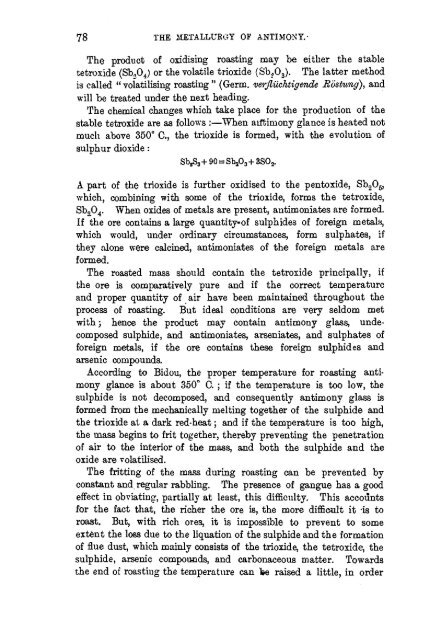antimony - Sciencemadness.org
antimony - Sciencemadness.org
antimony - Sciencemadness.org
Create successful ePaper yourself
Turn your PDF publications into a flip-book with our unique Google optimized e-Paper software.
78 THE METALLURGY OF ANTIMONY.-<br />
The product of oxidising roasting may be either the stable<br />
tetroxide (Sbo04) or the volatile trioxide (Sb2O3). The latter method<br />
is called " volatilising roasting " (Germ, verfiuchtigende Rostung), and<br />
will be treated under the next heading.<br />
The chemical changes which take place for the production of the<br />
stable tetroxide are as follows :—"When <strong>antimony</strong> glance is heated not<br />
much above 350° C, the trioxide is formed, with the evolution of<br />
sulphur dioxide:<br />
SbsS3 + 90=Sb2O3 + 3SO2.<br />
A part of the trioxide is further oxidised to the pentoxide, Sb2O5,<br />
which, combining with some of the trioxide, forms the tetroxide,<br />
Sbo04. When oxides of metals are present, antimoniates are formed.<br />
If the ore contains a large quantity of sulphides of foreign metals,<br />
which would, under ordinary circumstances, form sulphates, if<br />
they alone were calcined, antimoniates of the foreign metals are<br />
formed.<br />
The roasted mass should contain the tetroxide principally, if<br />
the ore is comparatively pure and if the correct temperature<br />
and proper quantity of air have been maintained throughout the<br />
process of roasting. But ideal conditions are very seldom met<br />
with; hence the product may contain <strong>antimony</strong> glass, undecomposed<br />
sulphide, and antimoniates, arseniates, and sulphates of<br />
foreign metals, if the ore contains these foreign sulphides and<br />
arsenic compounds.<br />
According to Bidon, the proper temperature for roasting <strong>antimony</strong><br />
glance is about 350° C.; if the temperature is too low, the<br />
sulphide is not decomposed, and consequently <strong>antimony</strong> glass is<br />
formed from the mechanically melting together of the sulphide and<br />
the trioxide at a dark red-heat; and if the temperature is too high,<br />
the mass begins to frit together, thereby preventing the penetration<br />
of air to the interior of the mass, and both the sulphide and the<br />
oxide are volatilised.<br />
The fritting of the mass during roasting can be prevented by<br />
constant and regular rabbling. The presence of gangue has a good<br />
effect in obviating, partially at least, this difficulty. This accounts<br />
for the fact that, the richer the ore is, the more difficult it is to<br />
roast. But, with rich ores, it is impossible to prevent to some<br />
extent the loss due to the liquation of the sulphide and the formation<br />
of flue dust, which mainly consists of the trioxide, the tetroxide, the<br />
sulphide, arsenic compounds, and carbonaceous matter. Towards<br />
the end of roasting the temperature can "be raised a little, in order
















